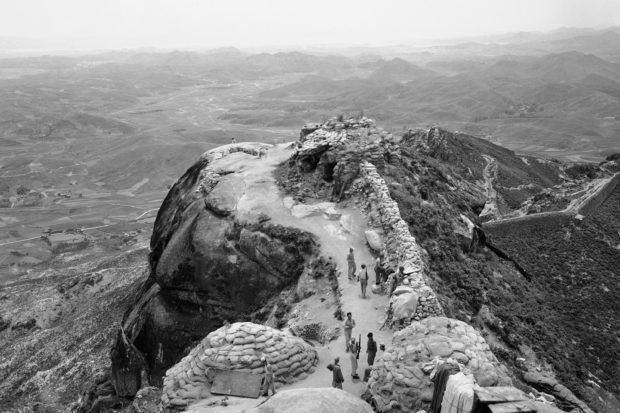China’s 1.4 billion people have gone through periods of tremendous upheaval and change under 70 years of Communist rule.

This June 8, 1950, file photo shows a view from South Korean front line lookout post along the 38th parallel, on the immediate left is South Korea. Communists control the territory in the right background and the valley which follows a winding course in the center distance. China backs North Korea in the Korean War and fights the U.S-led coalition to a standstill at the 38th parallel in 1953. (AP Photo/Charles Gorry, File)
The once impoverished war-torn country has grown into the world’s second-largest economy. In between, tens of millions died in the Great Leap Forward, which was anything but that; the Cultural Revolution ushered in a decade of chaos and a brutal crackdown on student protesters snuffed out hopes for democracy.
It has been a long march for the Chinese Communist Party, which came to power on October 1, 1949, after defeating the Nationalist Party in a civil war. The Nationalists retreated to Taiwan, moving their rival government there.
In this Oct. 16, 1964, file photo, a cloud of an atomic explosion billows skywards as China conducts its first successful atomic bomb test. (AP Photo, File)
EARLY UPS AND DOWNS
1950: China backs North Korea in the Korean War and fights the U.S-led coalition to a standstill at the 38th parallel in 1953.
1950s: Technical assistance from the Soviet Union helps develop industry and agriculture. Landlords are executed, their land given to peasants.
1957: An anti-rightist campaign begins to purge intellectuals deemed to be anti-socialist.
1958-1960: The Great Leap Forward to transform the agricultural nation into an industrial power is an economic disaster. By some estimates, 30 million people die in a resulting famine.
1959: The Dalai Lama, Tibet’s leader, flees into exile.
JOINING THE WORLD, THE RED GUARDS
1964: China conducts its first successful atomic bomb test.
1966: Leader Mao Zedong launches the ultra-radical Cultural Revolution to reassert his authority. Schools are shut, youthful Red Guards attack political enemies and intellectuals are persecuted or driven to suicide.
In this Nov. 7, 1957, file photo, China’s Mao Tse-tung, third from left, and top Russian leaders salute from Lenin Mausoleum as parade passes below in Red Square in Moscow. China and Soviet Union enjoy a smooth relationship in the beginning of the 50s. From left are then President Dmitri, Voroshilov, Defense Minister Marshal Rodion Y. Malinovsky, who replaced Marshal Zhukov; Mao; communist party boss Nikita Khrushchev; Premier Nikolai Bulganin; Deputy Premier A.I. Mikoyan and M.A. Suslov, a member of ruling presidium. (AP Photo, File)
1971: The U.N. recognizes the communist government in Beijing as China’s representative, replacing Taiwan. A U.S. table tennis team visits Beijing in “pingpong diplomacy” that sets the stage for further exchanges.
1972: Richard Nixon becomes the first American president to visit Communist China.
1976: Mao dies at age 82. The Tangshan earthquake in northeastern China kills more than 240,000 people.
OPENING UP, BUT NOT POLITICALLY
1978: Leader Deng Xiaoping introduces market-style reforms, allowing small-scale free enterprise but leaving in place the dominant state-owned companies.
1979: China and the U.S. establish diplomatic relations.
In this June 5, 1989, file photo, a Chinese man stands alone to block a line of tanks heading east on Beijing’s Cangan Blvd. in Tiananmen Square. The man, calling for an end to the recent violence and bloodshed against pro-democracy demonstrators, was pulled away by bystanders, and the tanks continued on their way. Thousands of students demonstrated for democracy in Tiananmen Square. Hundreds died when the government sent in troops. (AP Photo/Jeff Widener, File)
1980: A policy allowing most couples only one child is launched nationwide. Special economic zones are created in Shenzhen, Zhuhai, Shantou, and Xiamen.
1989: Thousands of students demonstrate for democracy in Tiananmen Square. Hundreds die when Deng decides to send in troops.
CHINA’S RISE
1990: Beijing hosts the Asian Games, the first major international sports event in China. McDonald’s opens its first Chinese outlet.
1997: Hong Kong, the former British colony, returns to Chinese rule under the principle of “one country, two systems.”
In this May 27, 1998, file photo, Chinese man sleeps with his legs draped across a Ronald McDonald mannequin outside the McDonald’s restaurant at the south end of Beijing’s Tiananmen Square. McDonald’s opened its first Chinese outlet in 1990. (AP Photo/Greg Baker, File)
2001: China joins the World Trade Organization.
2003: The SARS (severe acute respiratory syndrome) virus kills more than 770 people, mostly in mainland China and Hong Kong. China sent a person into space on its own, the third country to do so after the Soviet Union and the United States.
2008: Beijing hosts the Summer Olympics. Violent anti-government protests erupt in Tibet. An earthquake in Sichuan province kills nearly 90,000 people.
GLOBAL POWER, FRICTIONS
2010: China surpasses Japan to become the second-largest economy. Imprisoned activist writer Liu Xiaobo is awarded the Nobel Peace Prize.
2013: China launches the Belt and Road Initiative to expand its trade and influence by building roads, ports and other infrastructure overseas.
2016: An international panel rules against China’s definition of its South China Sea territorial claims, but China continues to expand its presence in the strategically important waters.
In this July 1, 1997, file photo, fireworks explode above performers at a show at Beijing’s Workers Stadium which marked the return of Hong Kong to Chinese sovereignty. Hong Kong, the former British colony, returns to Chinese rule under the principle of “one country, two systems.” (AP Photo/Katsumi Kasahara, File)
2018: President Donald Trump starts a tariff and trade war with China as concern grows over China’s challenge to U.S. technological might. The legislature scraps term limits, setting the stage for Xi Jinping to rule indefinitely.
2019: Major democracy protests erupt in Hong Kong, raising questions about the viability of the “one country, two systems” framework that China applies there and wants to extend to Taiwan. /kga